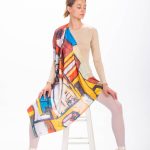Sustainable fashion is not a trend, it’s a responsibility.
The urgency of environmental sustainability in fashion
There is no doubt in mind that environmental sustainability is a top-of-mind concern for every fashion insider today. The industry accounts for 10% of carbon emissions and also 20% of wastewater annually. Not only are consumers demanding more sustainable and ethical fashion, but government legislative bodies are also beginning to do the same by tightening regulations and imposing new laws, such as Anti-Waste and Circular Economy, and Climate and Resilience laws for the EU and the Fashion Sustainability and Social Accountability Act in New York. Finding themselves wedged between their government and consumers, fashion companies are realizing that sustainability is now a non-negotiable in the business. The faster they comply with these new regulations and future laws, the more prepared they will be and skillful in balancing profitability with sustainability. They will be also ahead of their competitors in aligning themselves with the values of their consumers, creating more business opportunities. The question now becomes: how can they go beyond the surface level and make it an integral, systematic part of their corporate strategy?
Going beyond the surface: How to start effecting real change in fashion
Competing in a market that is complicated by sustainability issues and facing more legal constraints is challenging. Fashion companies will need to start incorporating sustainable practices at every stage of their production processes, in order to transform their business on a deeper level. According to a Forbes article, there are three ways in which sustainability strategies can be implemented: awareness, materials and processes. They can spread awareness by informing the consumer about the environmental impact of their items, use more eco-friendly materials or fabric more correctly, and rethink and change their production processes to make it less wasteful in terms of energy and fabric consumption.
At Lectra, we have developed integrated solutions to help our customers in these three ways. A powerful combination of software, equipment, data and services, our product offerings help them understand where in the lifecycle these sustainability impacts occur and how to solve them with improved efficiency, costs-savings and product quality. Through our technology, our customers can become more informed about their suppliers. We can help them plan and develop products with more sustainable, complex materials. Most importantly, we can empower them to reinvent the way they produce, with a leaner and zero-waste approach.
Above all, we have identified the most fundamental and effective step to improving sustainability and profitability at the same time. A fashion company should always start by assessing its cutting room, where the biggest amount of fabric waste is generated. The nesting-to-cutting process determines how much fabric gets tossed out, reworked, and recycled. Setting the right parameters for the process itself is pivotal. Efficient markers enable cutting room operators to plan their cuts wisely and fully utilize their fabric. Cutting at a lower ply height and ensuring minimal buffer between parts help companies produce in smaller, more frequent series to jump on micro-trends and satisfy fluctuating order volumes without incurring waste. Another option for them is to switch to on-demand production, so that they can manufacture items only after order reception, to avoid over-reliance on demand forecasts that often result in overstock or deadstock. Let us demonstrate how.
It’s all in the fabric: optimizing consumption
Fabric accounts for 60-70% of the total cost of a garment, and it’s a make-or-break factor for every company’s bottom line. On the flip side, material consumption is also a major indicator of waste management performance. Each millimeter of fabric saved matters when you want to minimize your environmental footprint. The key to fabric waste reduction is preventing it from happening in the first place, which is to procure the right quantity at the pre-production stages.
The ability to predict your fabric consumption is the key to achieving that very outcome. Our automated nesting solution, Flex Offer by Lectra, allows you to run highly efficient markers and costing calculations in the cloud to help you improve your fabric procuration process while ensuring that you are respecting your budget constraints. Thanks to the cloud’s limitless capacity, you can run high volumes of calculations at the same time, without disrupting your actual nesting process for your current production line, even during peak periods.
Making the cutting room leaner
The cutting process plays a significant role in reducing fabric waste, because it’s all about ensuring a high cut quality with durable, sharp blades to avoid errors and rework. The operation should be seamless, with the least disruption possible to prevent further mistakes. To increase fabric savings, the most ideal situation is to have minimal buffer between cut parts, combined with automated lay plans. As mentioned before, having the agility to cut in small- to medium-sized batches also allows companies to respond to shifting market demands more efficiently, without causing any surpluses.
Our new low-ply cutting equipment, Vector iX and Q2, enables companies to produce small series with zero-buffer cutting with a ply height of 2.5 cm. They also come with preventive and predictive maintenance, round-the-clock technical support and sensors to alert operators before failure occurs to maximize machine uptime. The eco-friendly design of both Vector iX and Q2 limits the manufacturing and transport-related carbon emissions of the cutter. And the new energy-efficient turbines cut down idling time, lowering power consumption, to emphasize resource optimization and sustainable production methods.
Flipping the production paradigm
If we explore the end of the spectrum, adopting a zero-inventory approach can also help solve the issue. This requires more investment, in terms of time and money, as fashion companies have to implement a new business model and change the way they produce. They have to transition from producing based on trend forecasts to on-demand manufacturing by launching the process only after the order has been made. This model also allows fashion companies to branch out into providing customization and personalization services. However, this usually leads to a longer time to market.
Our on-demand production solution, Fashion On Demand by Lectra is developed just for this purpose. By connecting and automating the entire process from order reception to cutting, the technology improves speed to market for on-demand manufacturing. Comprising a single-ply cutting machine Virga and Digital Cutting Platform, this solution allows fashion companies to go from small-batch to one-off production runs, giving them the ability to handle customized and made-to-measure garments with speed and ease.
Sustainability starts in the cutting room
For companies that are starting their sustainability journey, their best bet is the cutting room. By just simply implementing the right technology and best practices to reduce fabric waste and energy consumption, they are already laying the path for a greener future in fashion.
Learn more about Flex Offer by Lectra, Vector iX and Vector Q2 and Fashion On Demand by Lectra here.



